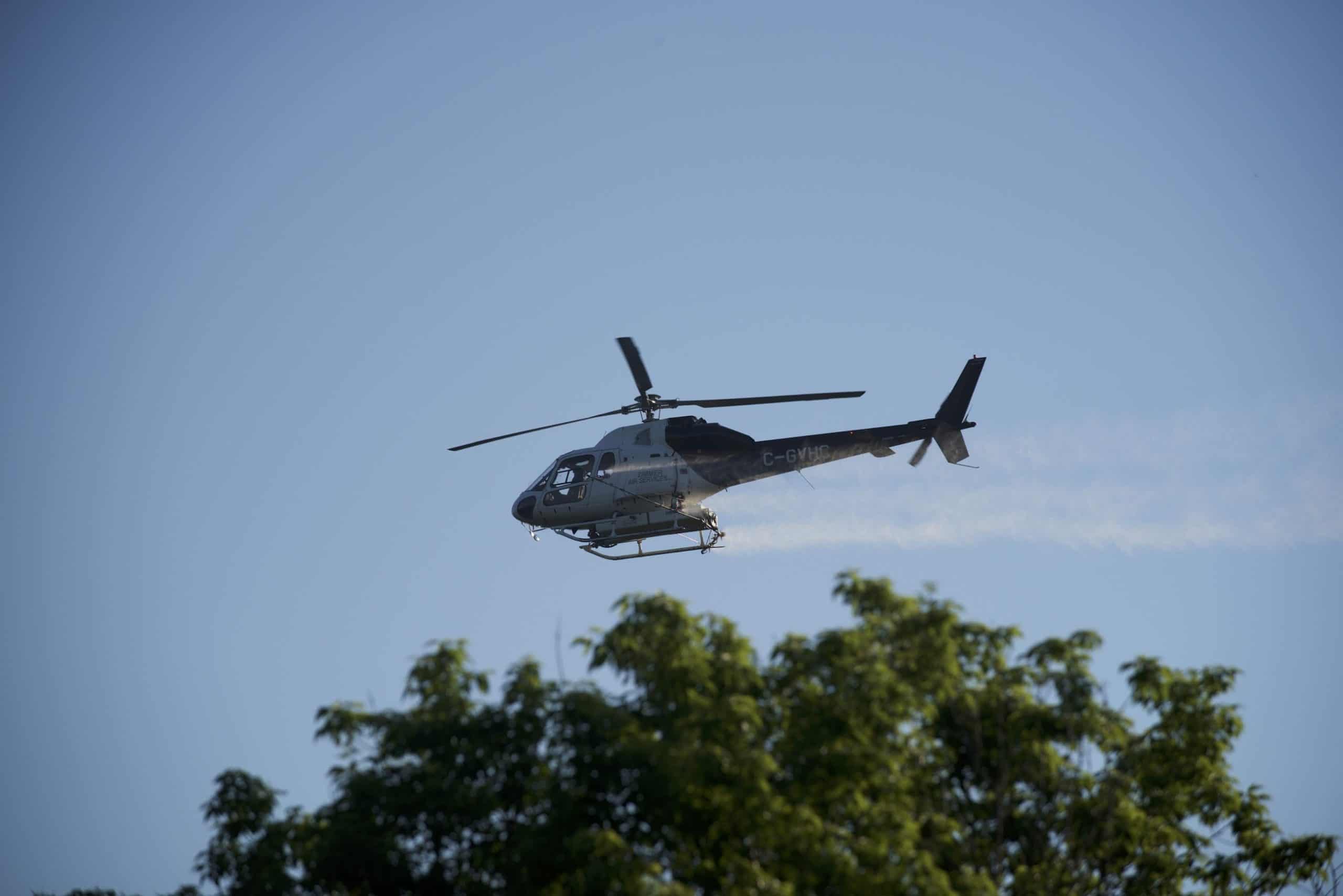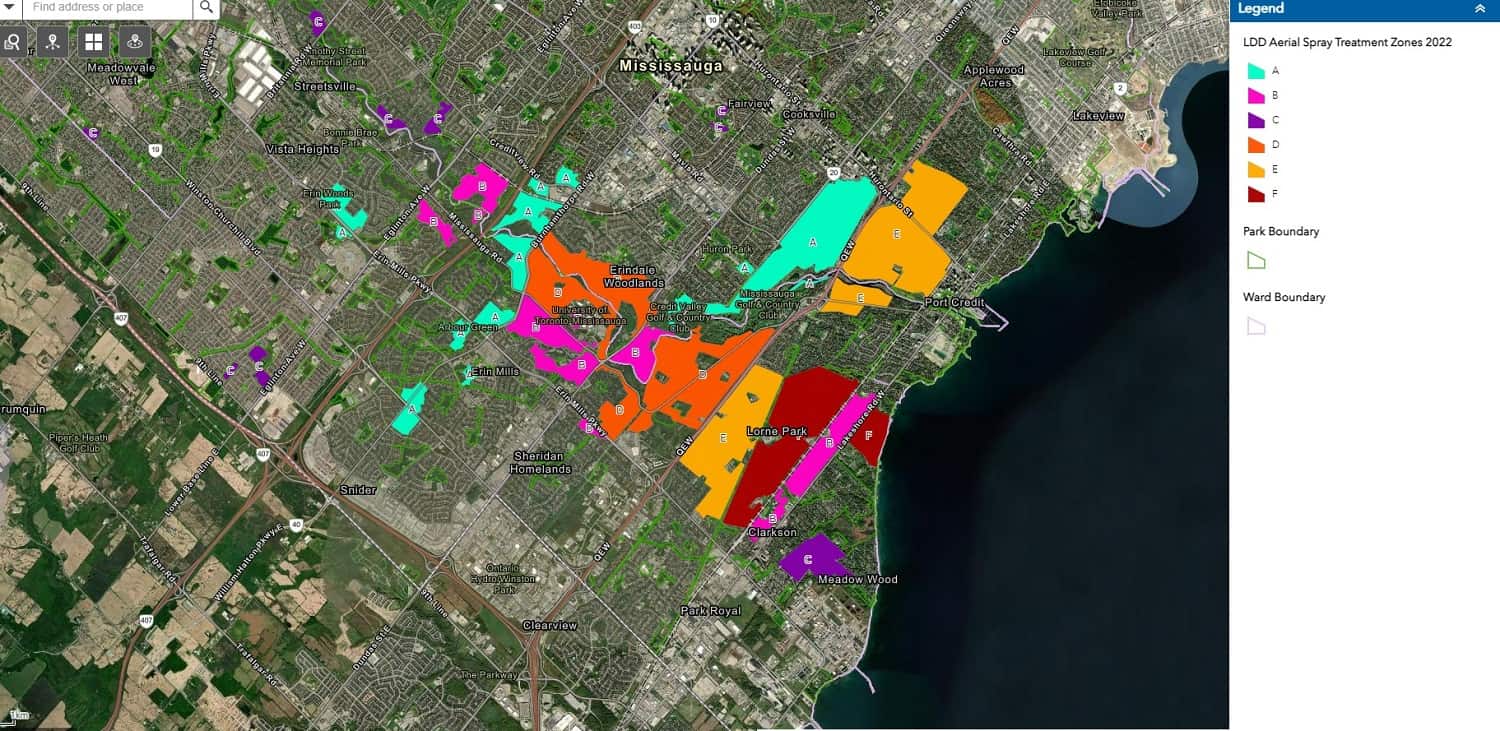Mississauga to use helicopters this Saturday to spray tree-killing insects
Published May 26, 2022 at 12:47 pm

Two helicopters will begin spraying areas of central and west Mississauga early Saturday morning (May 28) in an effort to save the city’s trees from an army of invasive, leaf-eating insects.
The low-flying aircraft will begin spraying at about 5 a.m. from 15 to 30 metres above the treetops in specific areas of the city plagued by the hungry bug.
Saturday’s effort, expected to take two to three hours to complete, marks the first in a series of planned air assaults in the coming weeks against what City of Mississauga officials formerly called the “gypsy moth.”
The City’s Aerial Spray Program now refers to the bothersome insects by their formal name, Lymantria dispar dispar (LDD), and officials say the objective is to “target and manage” the leaf-munching caterpillars, which left unchecked can kill trees at an alarming rate.
City officials say it’s important that all Mississauga residents are aware of when, where and how the aerial spray will be used over the next month or so. They add there may be some temporary closures of parks, trails and roads while spraying takes place.
Saturday’s spraying targets Mississauga communities identified by the aerial program as spray zones A, D and E (portions of the latter two zones), which can be viewed using an interactive map provided by the City.
Essentially, Zone A starts at Old Carriage Rd., south of Dundas St. W. and near Credit Valley Golf Club, and then moves eastward towards Hurontario St. tracking, for the most part, south of The Queensway and north of the QEW.
Zone D covers much of the Erindale Woodlands and then areas in and around Mississauga Rd. as you travel south of Dundas St. W. to the QEW.
Zone E includes areas south of the QEW, from Mississauga Rd. to neighbourhoods several blocks east of Hurontario St., in addition to areas in the southeast quadrant of the Southdown Rd./QEW intersection.

Map shows the different zones in Mississauga targeted under the City of Mississauga’s Aerial Spray Program. (Map: City of Mississauga)
The City notes that spraying in zones D and E will take place during round one over multiple days in attempts to minimize road closures and traffic disruptions. Residents are urged to check the City’s website for specific updates on spraying.
Aerial spraying may be rescheduled to later dates if weather conditions change, the City adds.
The “gypsy moth,” or LDD, has been an unwelcome presence in Mississauga for years and it’s a serious threat to the tree canopy in several parts of the city as it eats oak trees and other hardwood species.
The aerial spray program is expected to protect hardwood trees like maple, oak, elm, ash, poplar, willow and birch.
While the City has used other methods to control the population of the insect, aerial spraying has been determined to be the most effective weapon.
Mississauga forestry staff received $3 million in the City’s 2022 budget with which to stage the latest aerial battle against the hungry pest.
The City last spray-bombed areas in 2018, which helped slow the LDD population for about two years. But within the past year-and-a-half or so, the tree-munching pest has returned in force in Mississauga and across southern Ontario.
The insecticide used is called Foray 48B, containing the active ingredient Bacillus thuringiensis subspecies kurstaki (Btk).
The spray produces fine droplets that are small enough to stick to the leaves of trees. Btk is a naturally occurring bacterium found in soil and has been approved by the Pest Management Regulatory Agency, an agency of Health Canada, for aerial use over urban areas.
According to Health Canada, Btk treatment is considered low-risk to human health and the environment. It is only toxic in the caterpillar stage of the LDD life cycle and does not affect adult moths or butterflies.
Last year, it was determined the “gypsy moth” was also making a nuisance of itself in another way.
People who came into close contact with heavily-treed areas developed rashes, which were not serious in nature, but caused symptoms of slight stinging and itchiness for several days.
Native to Europe, LDD was introduced to North America several decades ago. The caterpillars eat leaves from trees during the spring and early summer.
While healthy trees can grow back their leaves in the same season, an ongoing infestation weakens trees and can make them more likely to be damaged from other insects as well.
insauga's Editorial Standards and Policies advertising





